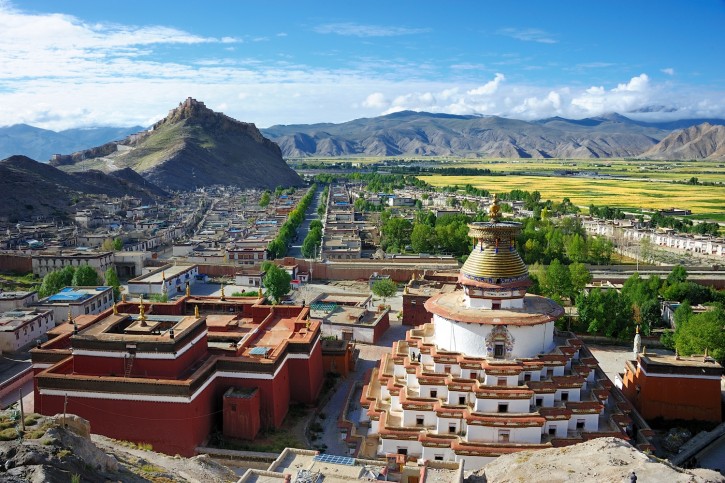

Bordered by Nepal on the South, Bhutan to east and India to east west, today the Autonomous Region of Tibet measures 2,600 km (1,625 miles) from east to west and 1,300 km (812 miles) north to south for a total area of 1,221,700 square km (471,900 square miles). The average elevation is 5,000 m (16,500 ft).
Bordered by Nepal on the South, Bhutan to east and India to east west, today the Autonomous Region of Tibet measures 2,600 km (1,625 miles) from east to west and 1,300 km (812 miles) north to south for a total area of 1,221,700 square km (471,900 square miles). The average elevation is 5,000 m (16,500 ft).
Tibet is cold in winter, cool in summer and generally dry, receiving only 45 cm. (18 inches) of rain or snow annually. Temperatures can differ greatly within a day, however, passing 29 C (85 F) in desert areas in summer, and plunging below 4 C (40 F) at night. The higher you go the colder it gets, of course, sunlight is extremely intense. Winds in winter are ferocious. Rainfall in Southern Tibet occurs intermittently between June and September, bringing moisture to barley fields and greenery to the valleys.
From March to October is the best period to travel to Tibet, when days are not too cold and the passes are clear of snow. Whereas for the festivals the best months are February, March and June-September. During the monsoon season June-September south of the Himalaya, Landslides can delay journeys through the mountains to Nepal.
Customs procedures for China are generally smooth and quick. On arrival you must complete a baggage declaration form on which you should declare personal valuables such as watches, cameras, radios, calculators, jewelry, foreign currency and travelers’ cheque, etc. Make sure you retain this form because you will have to present it together with your valuables at customs again on your departure. Export of antiques over 120 years old will need special permission and customs may confiscate other antique items if they think they’re from a dubious Source.
The choice of entries and exits for Tibet has recently increased to include more international access to Lhasa. There are direct flight into Lhasa from Kathmandu Chengdu, Beijing (via Chengdu) and Xian (via Golmud). Apart from the Kathmandu-Lhasa flight, Nepal overland route to Lhasa has become a very popular. Recently another entry point to Tibet from West Nepal (Simikot) has been opened.
08 hours ahead of GMT. Note Tibet is linked to Beijing time so when you cross the border to Nepal the time change is considerable. Nepal is 5 hours and 45 minutes ahead of GMT.
RENMINBI, the People’s money used by millions of Chinese every day, circulates in notes of 1, 2, 5, 10 and 50 Yuan; 1, 2 and 5 Jiao; 1, 2 and 5 fen. There are also coins for 5 fen. With the Chinese Currency, Renminbi, one Yuan is divided into 10 Jiao; Jiao into 10 Fen.
All major currencies, travelers’ cheque and credit cards are accepted by the Bank of China and large tourist hotels in Lhasa. When you change at the bank you will receive a money exchange receipt which details the transaction. Keep the exchange receipt you can use it to reconvert your left over Chinese currency when you leave.
The Bank of China is clcr, e to Public Security Bureau, just behind the Potala. Opening hours art from 1000 hrs to 1330 hrs and from 1600 hrs. to 1830 hrs. Its clad ill day on Sunday.
Most shops are open between 0900 hrs and 1230 hr; and then again from 1430 hrs. until 1730 hrs. Many shops: dose~on Sundays. Government offices are usually closed on Saturday afternoon land a day Sunday.
April to October light clothing are required. The recommended items are: Sleeping bag, shirts, comfortable walking shoes, Long John Trousers and shirts, sweater, jackets, dust mask, socks, sun hat, sun glasses, sun tan lotion, utility knife, water bottle/thermos (litre) flashlight. Water purification tabs, medicine for headaches, fewer, colds stomach disorders etc. Toilet papers and tissue papers.
Lhasa Gonggar Airport is 96 km away from Lhasa.
The airport departure tax at present is approx. US$12 per person
Transportation will be either in a Land cruiser or Mini-Van depending on the size of the group.
Tibet has only a handful of towns, and Tibetan cuisine is not exactly the most varied in the world. It is handy to carry, anything that can be brewed with hot water. Instant coffee, drinking chocolate, tea bags, soup cubes, drink powder and powdered milk. Other food items worth considering are instant noodles, vegemite, nuts and’ raisins, chocolate, dry foods and biscuits.
No special inoculations are required but because 0f Tibet’s high altitude travelers with a pre-existing problem of heart, lungs or anemia should consult a doctor before even thinking about a visit. Most other travelers, once they are acclimatized, rarely suffer more than mild discomfort from the altitude.
Over exertion seems to contribute to mountain sickness and dehydration may be a predis-posing factor. Sensible precautions should include:
It is not unusual to wake up at night at high altitudes gasping for breath. Don’t panic! This complaint, known as “Periodic Breathing”, is normally quite harmless, caused by a change in the control of breathing within the brain while you sleep. Normal breathing can be quickly re-established by relaxation, rhythmic deep-breathing, and the understanding that there is nothing to worry about.
© 2011 - 2025 All rights reserved. Life Dream Adventure. Developed By: Xenatech Nepal.